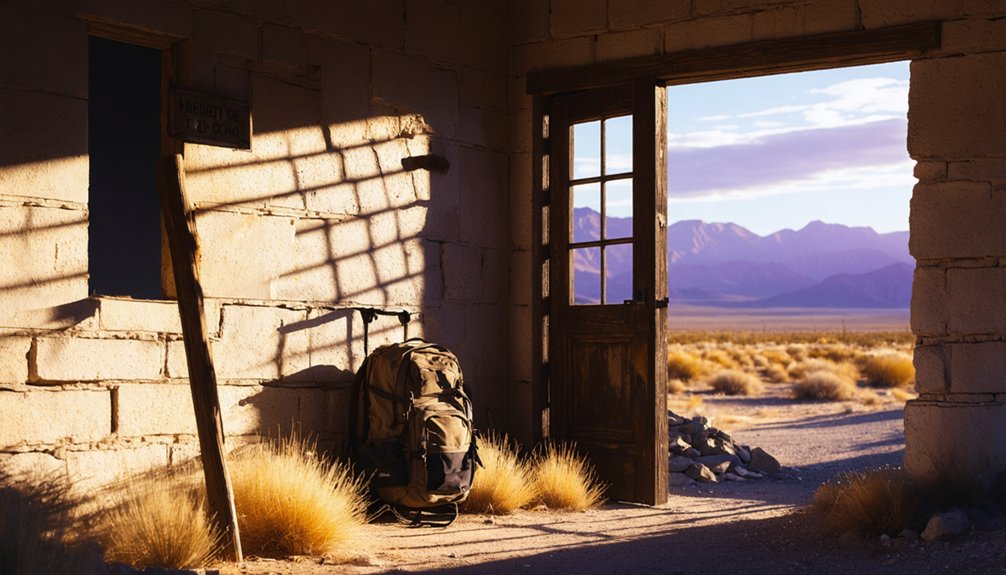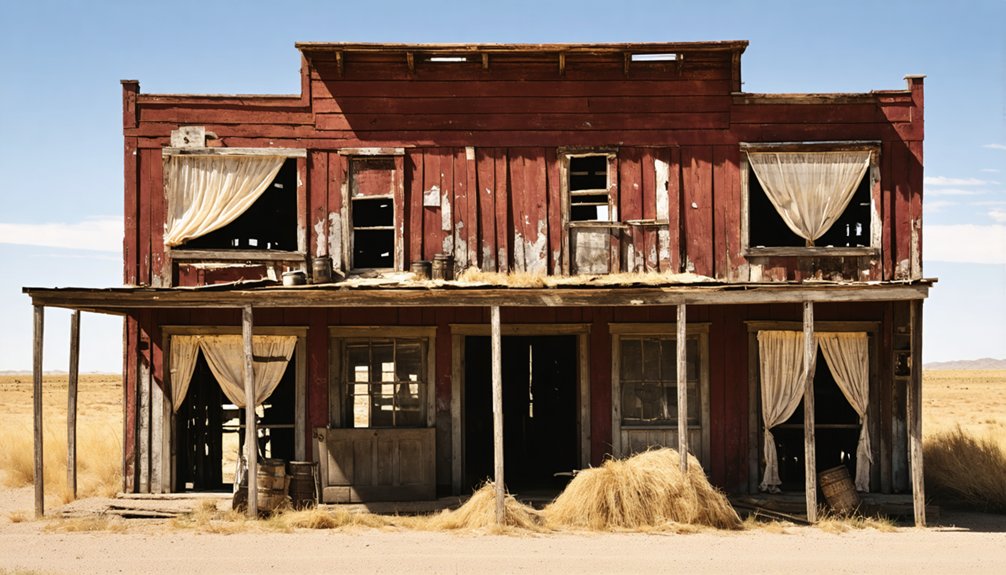You’ll find Lowell’s ghostly remnants along Erie Street, where preserved 1950s storefronts tell the story of a once-thriving copper mining community. Founded in 1879 by W.S. Salmon, the town peaked during its mining heyday with a 900-foot shaft employing 60 workers. The Lavender Pit’s expansion in 1974 transformed Lowell into a ghost town, but dedicated volunteers maintain its vintage architecture and hand-painted signage. The weathered structures hold countless tales of America’s copper mining past.
Key Takeaways
- Lowell was established in 1879 as a copper mining town, reaching peak operations in 1899 with 60 workers and $10,000 monthly payroll.
- The expansion of Lavender Pit copper mine required demolition of most residential areas, leading to the town’s eventual abandonment.
- Erie Street remains as the last preserved segment of Lowell’s commercial district, featuring authentic 1950s storefronts and vintage architecture.
- The town became a ghost town after copper mining operations ceased in 1974, following the production of 600,000 tons of copper.
- Today, Erie Street serves as a living museum and film location, maintained by volunteers through The Lowell Americana Project.
The Rise of a Copper Mining Community
While copper mining claims in Lowell, Texas dated back to 1879 under W.S. Salmon, serious community development didn’t begin until 1899.
That’s when Frank Hanchett from Lowell, Massachusetts, acquired the property and established the Lowell & Arizona Copper Mining and Smelting Company.
In 1899, Lowell’s fortunes shifted when Frank Hanchett arrived from Massachusetts to launch his ambitious copper mining enterprise.
You’ll find the mining infrastructure quickly took shape with extensive timber construction and a sophisticated two-compartment shaft reaching 900 feet deep by year’s end.
The operation attracted skilled workers and brought essential services to the area, including medical care from Dr. L. Edmundson and Dr. C.L. Caven.
Despite occasional setbacks, like a three-week delay from a broken hoist gear in 1900, the mine’s steady growth drove the establishment of transportation networks and ancillary businesses, transforming Lowell into a bustling frontier mining town. Like many copper mines in Texas during this era, low-grade ore prevented sustained commercial success.
The mining operation employed 60 workers with a monthly payroll of $10,000 by late 1899, demonstrating its significant economic impact on the region.
Erie Street’s Commercial Legacy
As the last surviving segment of Lowell’s once-bustling commercial district, Erie Street stands as a poignant tribute to the town’s mining heyday.
You’ll find this remarkable avenue filled with commercial nostalgia, from rusting vehicles to an old Greyhound bus frozen in time. The area declined dramatically when the open-pit copper mine expanded into residential zones. The historic street has become a film production location for various movies and music videos. Community resilience shines through as volunteers work tirelessly to preserve this historic thoroughfare.
During Erie Street’s peak, you’d have discovered:
- A vibrant mix of saloons, boarding houses, and the district’s first movie theater
- Essential services including a railroad depot, post office, and livery stable
- The Sprouse Reitz Co. department store and numerous eateries catering to miners
Today, while most businesses have vanished, dedicated residents maintain Erie Street as a living museum, ensuring its legacy endures through restoration projects and experiential visits.
Mining Operations and Economic Impact
When W.S. Salmon first staked his claim in 1879, he couldn’t have predicted the dramatic transformation that would unfold. The real mining profits began flowing after Frank Hanchett’s 1899 purchase, when he established the Lowell & Arizona Copper Mining and Smelting Company.
You’ll find that rapid development followed, with a 900-foot shaft and substantial timber infrastructure constructed within months. Similar to the Lowell mills of Massachusetts where workers earned wages up to $3 weekly, the mine offered competitive compensation to attract labor.
The labor dynamics proved complex, with both skilled and unskilled workers contributing to operations. Large monthly payrolls sustained the local economy, while company-provided medical services helped stabilize the workforce. Today, the area has been largely engulfed by the Lavender Pit Mine.
Skilled miners worked alongside laborers, their steady wages and access to medical care creating a stable mining community.
Even when a major hoist gear failure struck in December 1900, the mine’s resilience showed through specialized repairs from Union Iron Works. This economic engine created ripple effects throughout the region, supporting ancillary businesses and fostering community growth around Lowell.
The Lavender Pit’s Transformation
After operating for decades as a major copper producer, the Lavender Pit transformed Lowell’s landscape into a stark representation of mining’s impact.
When operations ceased in 1974, you’d find a massive 300-acre pit stretching 900 feet deep, forever changing the region’s topography. The pit produced approximately 600,000 tons of copper throughout its operational lifetime. The site was named after mining engineer Harrison M. Lavender who had overseen operations in the area.
The mining legacy left behind three dramatic changes:
- The demolition of most of Lowell’s residential district to accommodate the pit’s expansion
- The deposit of enormous waste rock piles around Bisbee and Lowell
- The creation of steep pit walls that remain a prominent geological feature today
You’ll now find this former mining site serving as both a tourist attraction and historical landmark, where visitors can observe firsthand the scale of mid-20th century copper mining operations and their lasting effects on the community.
Preserving Mid-Century Americana
As you stroll down Erie Street, you’ll find meticulously preserved 1950s storefronts maintained by the Lowell Americana Project‘s dedicated volunteers.
The preservation efforts include period-accurate paint schemes, vintage signage, and authentic commercial façades that recreate the mid-century character of this once-bustling mining town. Local volunteers help to keep this ghost town charm alive through various restoration initiatives. Many filmmakers have found the street’s vintage aesthetic perfect for productions like Stephen King’s Desperation and Young Guns II.
Each storefront, from the old Greyhound bus terminal to the Shell gas station, tells the story of American small-town life during the post-war boom through carefully curated details and historically accurate restoration.
1950s Storefronts Still Standing
The storefronts of Lowell stand as weathered sentinels of mid-century Texas commerce, offering glimpses into the state’s bygone era of small-town prosperity.
You’ll find these architectural remnants along what was once a bustling main street, where ghost town nostalgia meets storefront preservation efforts against the harsh Texas elements.
As you explore these time-worn structures, you’ll discover:
- Original wooden facades with large display windows, though many now show signs of weather damage
- Former general stores and post offices with vintage signage frames still intact
- Interior spaces that occasionally reveal old furnishings and fixtures from the town’s heyday
These storefronts tell compelling stories of economic shifts, from railroad-driven growth to eventual decline as modern highways bypassed the community, leaving behind these silent testimonies to Texas’s commercial heritage.
Vintage Signs Tell Stories
Vintage signs scattered throughout Lowell’s weathered streets serve as vibrant storytellers of mid-century Americana, offering you glimpses into the town’s commercial heyday.
Through sign preservation efforts by the Lowell Americana Project, you’ll discover porcelain enamel advertisements, civic markers, and remnants of local businesses that once thrived here.
These carefully restored pieces employ storytelling techniques that transport you back to the 1940s and ’50s, when bold typography and distinctive mascots dominated the visual landscape.
You’ll notice the absence of certain red pigments, banned for toxicity, while examining the period-accurate materials and craftsmanship.
As you explore Erie Street’s authentic 1950s streetscape, each sign reveals layers of local history, from bustling copper mining operations to the everyday commerce that once defined this Texas community.
Architectural Treasures Along Erie Street
You’ll find Erie Street’s architectural treasures perfectly preserved in its classic storefronts, complete with hand-painted signage, period-appropriate fonts, and vintage retail displays visible through original windows.
The street’s preserved gas stations showcase authentic Gulf and Shell pumps, harkening back to mid-century automotive culture.
These commercial structures maintain their 1950s character through simple brick and wood facades, while neon lights and period-specific advertising elements reinforce the authentic small-town atmosphere.
Vintage Shop Design Elements
Along Erie Street’s quarter-mile stretch, an impressive collection of mid-century commercial buildings captures the essence of 1940s-1970s American design.
You’ll discover vintage aesthetics in every storefront, from the restored Gulf Gas Station to the old movie theater and five-and-dime store. The nostalgic ambiance comes alive through hand-painted signs, neon lighting, and authentic window displays featuring historic merchandise.
The Lowell Americana Project’s volunteers have preserved these architectural treasures with:
- Period-accurate replicas of lost signage and promotional banners
- Restored storefronts showcasing classic typography and brand logos
- Window displays featuring mannequins and vintage appliances
Inside remaining businesses like the Bisbee Breakfast Club, you’ll find chrome accents, formica tabletops, and diner booths that transport you back to the 1950s.
Classic Gas Station Features
Standing proudly at the north end of Erie Street, the Shell Gas Station remains a pristine example of mid-century service station architecture.
You’ll find the original structure showcases classic yellow and red Shell branding, complemented by vintage fuel pumps that transport you back to a simpler era.
The nostalgic design features wood and brick construction, with a rectangular layout topped by a protective canopy over the fueling area.
You’ll notice period-correct details like hand-painted signage, retro typography, and mechanical pump displays.
The station’s glass windows and doors create an inviting atmosphere that was typical of customer service in the 1950s.
Thanks to the Lowell Americana Project‘s dedicated volunteers, this architectural treasure continues to serve as a perfectly preserved slice of automotive history.
Life in a 1950s Mining Town

While life in 1950s Lowell centered around copper mining, the town bustled with activity along Erie Street, where miners and their families frequented local shops, saloons, and the movie theater.
Living in this close-knit community, you’d find mining families building their lives around:
- Daily work routines of physically demanding underground copper extraction
- Community gatherings at social hubs like the local movie theater and saloons
- Shopping at “five and dime” stores, pharmacies, and auto dealerships
You’d walk to work from your modest home near the mines, or perhaps catch a Greyhound bus for longer trips.
Despite the tough labor conditions, you’d feel the strong sense of community pride evident in the thriving businesses along Erie Street.
However, by the mid-1970s, mine closures would force many residents to leave, transforming this vibrant town into a ghost town.
The Lowell Americana Project’s Mission
The Lowell Americana Project emerged in response to Erie Street’s transformation from bustling mining town to abandoned streetscape.
You’ll find its mission centers on cultural preservation, with volunteers working tirelessly to restore the street as a living time capsule of mid-20th century America. Through community engagement, locals contribute their time and resources to revive vintage gas stations, pharmacies, and other historic structures.
The project’s vision extends beyond preservation – it’s creating economic opportunities through heritage tourism.
You’ll see how Erie Street has become one of the west’s most photographed locations, attracting filmmakers, musicians, and artists. Through public art installations and media collaborations, the project’s turning this historic district into an outdoor gallery celebrating Americana while educating visitors about America’s cultural heritage.
Modern Tourism and Ghost Town Experience

As visitors venture into Lowell’s ghostly remains, they’ll discover a raw, unfiltered glimpse into Texas’s abandoned past through its scattered collection of weathered general stores, post offices, and vintage gas stations.
The authentic heritage preservation efforts have maintained key structures while keeping modern amenities minimal, letting you experience the site on your own terms.
When exploring Lowell’s ghost town tourism offerings, you’ll find:
- Self-guided exploration opportunities through buildings with original furnishings
- Seasonal events celebrating regional history and local folklore
- Natural outdoor activities that complement your historical adventure
Your visit supports local communities while satisfying the growing demand for authentic heritage experiences.
Remember to prepare for rustic conditions – that’s part of the genuine ghost town experience you’re seeking.
Historical Significance in the American Southwest
Founded in the early 1900s during a regional mining boom, Lowell emerged as an essential copper mining settlement that would shape the economic landscape of the American Southwest.
You’ll find a rich mining heritage in its story, where the town’s population swelled to 5,000 residents by 1915, supported by one of the world’s largest copper producers. The community dynamics centered around Erie Street’s bustling commercial district, featuring auto dealerships, pharmacies, and department stores that served the region’s mining families.
The town’s significance extends beyond economics – it’s a reflection of the boom-and-bust cycle of the American mining industry.
While the expansion of the Lavender Pit ultimately led to Lowell’s decline, its preserved 1950s-era structures now stand as powerful reminders of the Southwest’s industrial past.
Frequently Asked Questions
Are There Any Paranormal or Ghost Sightings Reported in Lowell?
Even with your smartphone’s ghost-hunting apps, you won’t find documented ghost encounters or haunted history here. Research doesn’t reveal any confirmed paranormal sightings, though Texas ghost towns often spark supernatural speculation.
What Happened to the Original Residents After They Left Lowell?
When you trace relocation stories, you’ll find most residents moved to nearby towns seeking jobs, while others integrated into Bisbee. Their resident legacies live on through preservation efforts and family histories.
Can Visitors Enter and Explore the Abandoned Buildings?
Like moths drawn to a flame, you’re technically able to explore abandoned buildings, but shouldn’t. Building preservation laws and safety concerns mean you should admire these historic structures from outside only.
Is There Lodging Available Within Walking Distance of Erie Street?
You won’t find lodging options within walking distance of Erie Street. You’ll need to seek accommodations in nearby towns and drive to local attractions for your ghost town exploration.
Does Lowell Host Any Annual Festivals or Special Events?
You won’t find any annual festivals or community traditions in this ghost town today. Historical records don’t show evidence of recurring special events, reflecting Lowell’s lack of active population or festival history.
References
- https://www.onlyinyourstate.com/trip-ideas/arizona/lowell-ghost-town-az
- https://www.top-ten-travel-list.com/blog/activities/exploring-lowell-a-ghost-town-near-bisbee-az/
- https://klaq.com/lowell-arizona-aricana-project/
- https://jamesbigleyranches.com/general/texas-ghost-towns/
- https://www.youtube.com/watch?v=9RdxvFycI84
- https://www.lowellmuseum.org/ghost-towns.html
- https://en.wikipedia.org/wiki/List_of_ghost_towns_in_Texas
- https://www.youtube.com/watch?v=pmjZbrDpQog
- https://www.bisbeeminingandminerals.com/lowell-mine
- https://tpwd.texas.gov/state-parks/copper-breaks/history



